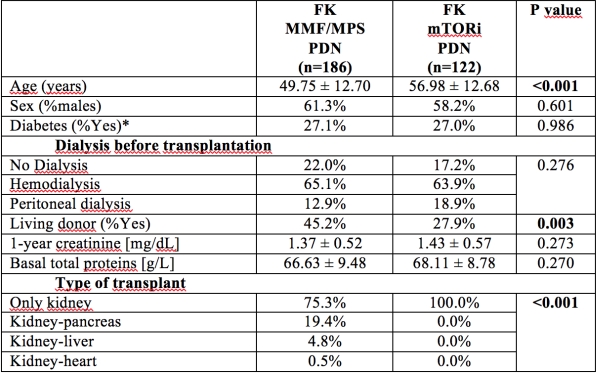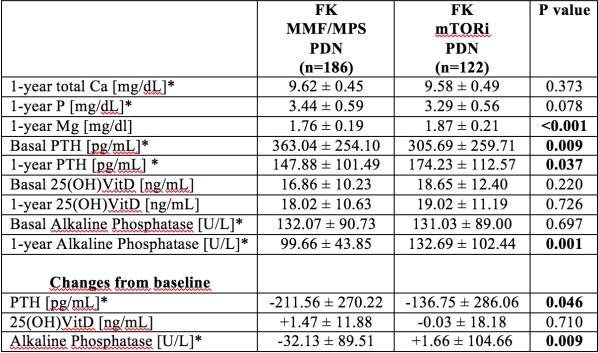The Impact of Immunosuppression on Mineral Metabolism One Year after Kidney Transplantation: Differences between a Mycophenolate-Based Regimen versus an mTOR-Inhibitor-Based One
D. Cucchiari,1 S. Karam,2 P. Ventura-Aguiar,1 F. Diekmann,1 J. Torregrosa.1
1Renal Transplant Unit, Hospital Clinic, Barcelona, Spain
2Department of Medicine, Saint George Hospital University Medical Center, Beirut, Lebanon.
Meeting: 2018 American Transplant Congress
Abstract number: A206
Keywords: Immunosuppression, Kidney transplantation
Session Information
Session Name: Poster Session A: Kidney: Cardiovascular and Metabolic
Session Type: Poster Session
Date: Saturday, June 2, 2018
Session Time: 5:30pm-7:30pm
 Presentation Time: 5:30pm-7:30pm
Presentation Time: 5:30pm-7:30pm
Location: Hall 4EF
INTRODUCTION: after kidney transplantation, a substantial amount of patients still suffer from Mineral Bone Disorder. The role of different immunosuppressive therapies on mineral metabolism in transplanted patients is largely unknown.
METHODS: longitudinal 1-year long study on patients transplanted from June 2013 to May 2016 at Hospital Clínic who were treated either with mycophenolate (MP) (n=186) or an mTOR inhibitor (mTORi) (n=122). These two drugs were always combined with both tacrolimus and prednisone. Patients who died within the first year, lost at the follow-up, with graft failure and those who changed immunosuppression during the first year were discarded from the final analysis (25.7% of original population).
RESULTS: mTORi patients were older and received more likely a graft from a cadaveric donor. There was no difference in renal function at 1 year between groups (p=0.273). 
Patients who were doing mTORi experienced a less significant decrease in PTH values 1 year after transplantation (PTH -211.56 ± 270.22 pg/mL for MP vs -136.75 ± 286.06 pg/mL for mTORi, p=0.046). Alkaline phosphatase decreased significantly in the MP group, while it did not substantially change in the mTORi group (-32.13 ± 89.51 U/L for MP vs +1.66 ± 104.66U/L for mTORi, p=0.009). There was a trend towards lower phosphate in the mTORi group (p=0.078), while total calcium was not affected (p=0.373). 
CONCLUSIONS: an mTOR inhibitor-based regimen is associated with higher PTH and alkaline phosphatase values 1 year after kidney transplantation when compared to a mycophenolate-based regimen, along with a standard tacrolimus and prednisone immunosuppression.
CITATION INFORMATION: Cucchiari D., Karam S., Ventura-Aguiar P., Diekmann F., Torregrosa J. The Impact of Immunosuppression on Mineral Metabolism One Year after Kidney Transplantation: Differences between a Mycophenolate-Based Regimen versus an mTOR-Inhibitor-Based One Am J Transplant. 2017;17 (suppl 3).
To cite this abstract in AMA style:
Cucchiari D, Karam S, Ventura-Aguiar P, Diekmann F, Torregrosa J. The Impact of Immunosuppression on Mineral Metabolism One Year after Kidney Transplantation: Differences between a Mycophenolate-Based Regimen versus an mTOR-Inhibitor-Based One [abstract]. https://atcmeetingabstracts.com/abstract/the-impact-of-immunosuppression-on-mineral-metabolism-one-year-after-kidney-transplantation-differences-between-a-mycophenolate-based-regimen-versus-an-mtor-inhibitor-based-one/. Accessed December 14, 2025.« Back to 2018 American Transplant Congress
